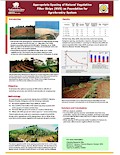| Poster |
 |
|
| Title | Appropriate Spacing of Natural Vegetative Filter Strips (NVS) as Foundation for Agroforestry System | | Author | Augustin R. Mercado Jr. and Luciano Laput | | Year | 2008 | | Publisher | World Agroforestry Centre - ICRAF, SEA Regional Office | | City | Bogor, Indonesia | | Call Number | PO0146-08 | | Keywords | Soil loss, natural vegetative filter strips, erosion control, crop area |
|
| Abstract: |
| Natural vegetative filter strip (NVS) is an attractive contour hedgerow system, because it is simple to establish and maintain, control soil erosion effectively, and compete less with associated annual crops than other alternatives. The recommended practice has been to space the hedgerows every 1 meter drop in elevation. This results in close hedgerow spacing (3-6 m apart) which removes considerable area from crop production approximately 10-20% loss. A collaborative study between the International Centre for Research in Agroforestry (ICRAF) and Misamis Oriental State College of Agriculture and Technology (MOSCAT) to determine the effect of NVS density on crop production and soil loss. We hypothesized that acceptable soil loss may be possible with fewer hedgerows, and tested the effect of hedgerow spacing on soil loss and crop yield in an experiment on a field with 50 meters slope length and 45% slope in an acid upland soils in Claveria, Misamis Oriental, Philippines (80 38’ N; 1240 25’ E). Soils are classified as acid upland soils with fine mixed isohyperthermic, Ultic Haplorthox or Oxic Dystropept with a soil depth more than a meter with low to moderate organic matter content, low in available phosphorus and exchangeable potassium. Average annual rainfall is 2800 mm distributed throughout the year with 10 months of growing season with peaks in the months of July and November. The natural vegetative filter strips (NVS) of 50 cm wide which was mostly composed of a mixture of Imperata cylindrica, Paspallum conjugatum and Chromolaena odorata were spaced in 1 m vertical drop (3 m apart), 2 m vertical drop (6 m), 4 m vertical drop (12 m), and 8 m vertical drop (24 m), and these were compared with open field control. Maize (var. Pioneer hybrid 3014) were planted two crops per year applied with Nitrogen (N), Phoshorus (P) and Potassium (K) at the rate of 80, 30, and 30 kg ha-1, respectively. We found out that a single NVS reduced soil loss by one half compared with the open-field control. As hedgerow density increased (4m, 2m, 1m) soil loss declined, but at a decreasing rate. Erosion did not differ significantly from the 2m and 1m drop, although the number of hedgerows doubled. Maize yield declined with increasing number of hedgerows. We conclude that it is most practical to establish the natural vegetative filter strips at a 2m or 4m elevation distance, which is about 10-12 meters apart. Even a single hedgerow is a good start for a farmer to tackle erosion with minimal investment and without significant loss of crop area. These wider spacing of NVS provide a good foundation for agroforestry where trees are spaced appropriately in order to avoid significant tree-crop competition. |
|